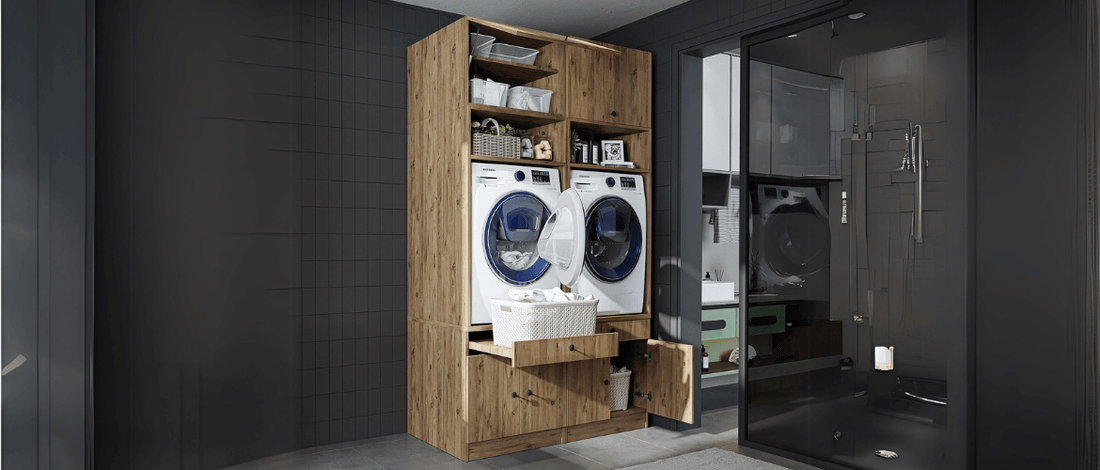
Washing machine cabinet with doors or better without
Share
The washing machine is part of the basic equipment in almost every household - but it is often not a visual highlight. If you want to make your bathroom, laundry room or utility room tidier and more homely, you'll want a washing machine cabinet to match. But then the question arises: with doors or leave them open? Both options have their advantages and disadvantages - depending on how much space is available, how often the machine is used and which style you prefer. In this article, we compare the options and show which solution suits which living style and everyday life.
Washing machine cabinet with doors: For a tidy overall look
A cabinet with doors offers a clean look - ideal for anyone who likes order and design. The washing machine disappears elegantly behind closed fronts, creating a harmonious overall look, particularly in open-plan living areas or modern bathrooms.
Advantages:
● Visual calm: No visible cables or connections, everything looks tidy.
● Dust protection: The machine stays cleaner, especially when not in use for longer periods.
● Sound insulation: Closed doors can dampen sound - depending on the material.
Disadvantages:
● Difficult to operate: Doors have to be opened to wash laundry, which can be inconvenient in small rooms or unfavorable cabinet designs.
● Heat build-up: Heat can build up if there is insufficient ventilation - important: make sure there are ventilation slots.
Conclusion: A wardrobe with doors is perfect for design lovers with enough space - as long as practical aspects such as ventilation are also considered.
Open washing machine cabinet: practical and ready for immediate use
Those who like it uncomplicated and use their washing machine frequently often opt for the open version - i.e. a washing machine cabinet without doors or with an open front.
Advantages:
● Direct access: No need to open and close doors - simply operate, done.
● Better ventilation: Heat and moisture can escape freely, extending the service life of the machine.
● Less expensive: Open models are usually cheaper to buy.
Disadvantages:
● Less aesthetic: The machine, hoses and sockets are visible. This quickly creates an unsettling effect, especially in living rooms.
● No protection against dust: Dirt can accumulate, especially when not in use for long periods.
Tip: If you prefer the open look, you can add style with decorative elements such as plants, storage baskets or laundry boxes.
Conclusion: The open version is ideal for practical people who appreciate quick access - especially in functional rooms such as laundry rooms or hallways.

Space requirements and dimensions: what you should look out for in both variants
Whether with or without doors - the dimensions are crucial if the cabinet is to fit the washing machine. Many people make the mistake of simply buying based on appearance without checking the exact space requirements.
Important dimensions:
● Width: Standard washing machines are usually 60 cm wide. The cabinet should offer at least 62-65 cm inside.
● Depth: Around 60 cm is also standard here. It is important that there is still room for power and water connections.
● Height: Many cabinets offer a work surface or storage space above - particularly practical in small rooms.
Special features for doors:
● Folding or hinged doors require additional opening space. This can be problematic in narrow bathrooms.
● Sliding doors save space, but are less common on washing machine cabinets.
Tip: When buying, look out for terms such as "suitable for front loaders" or "universal fit". And always measure - including the height of the water connection!
Conclusion: The wardrobe only works in everyday life with the right dimensions - whether open or closed.
Choice of materials and style: how the wardrobe fits into the room concept
Today, washing machine cabinets are available in many materials and designs - from plain white to modern wood decors or industrial metal frames.
Popular materials:
● Melamine-coated chipboard: Inexpensive, easy to clean and available in many colors.
● MDF with foil coating: Slightly higher quality, more resistant to moisture.
● Solid wood or real wood veneer: Rarer, but particularly classy - ideal for homely bathrooms.
● Metal & glass: For modern, industrial looks.
Styles:
● Scandinavian: Light woods, clean lines, combined with white or pastel shades.
● Minimalist: Handleless fronts, matt white or anthracite - timeless and calm.
● Vintage or country house style: Playful details, warm wood colors, classic handles.
Tip: Coordinate the wardrobe with other furniture and colors in the room - so everything looks like it's from a single source.
Conclusion: The washing machine cabinet can be discreetly understated or deliberately accentuated - depending on your style preferences.

Functional extras: more than just a cabinet for the washing machine
A good washing machine cabinet offers more than just cladding - it can have well thought-out functions that make everyday life easier.
Possible extras:
● Integrated worktop: Ideal for folding or sorting laundry.
● Storage compartments and baskets: For detergent, fabric softener, clothespins etc.
● Adjustable feet: For a secure stand, even on uneven floors.
● Door dampers or soft-close systems: For convenient opening and closing.
For combined appliances: Some cabinets offer space for a washing machine and tumble dryer on top of each other - with secure fixing and anti-vibration elements.
Tip: Look out for models with well thought-out cable and hose routing - this keeps everything tidy.
Conclusion: If you pay attention not only to appearance but also to function, you will get the most out of your washing machine cabinet - whether with or without doors.
